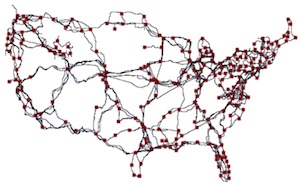
The study shows where to find the main conduit routes in the U.S. Click for more.
A study by four researchers – Ramakrishnan Durairajan, Paul Barford, Joel Sommers and Walter Willinger – comes to the conclusion that the more conduit is shared by different fiber optic network operators, the greater the risk of disruption, essentially due to the fact that one careless backhoe operator can take out several key routes all at once. It’s a counter-argument, they say, to those (such as myself) who push for policies that encourage installing as much and as many fiber strands as possible any time a street is cut open…
A striking characteristic of the constructed US long-haul fiber-optic network is a significant amount of observed infrastructure sharing. A qualitative assessment of the risk inherent in this observed sharing of the US long-haul fiber-optic infrastructure forms the second contribution of this paper. Such infrastructure sharing is the result of a common practice among many of the existing service providers to deploy their fiber in jointly-used and previously installed conduits and is dictated by simple economics—substantial cost savings as compared to deploying fiber in newly constructed conduits…
We show that both robustness and performance can be improved by deploying new fiber routes in just a few strategically-chosen areas along previously unused transportation corridors and [right of way (ROW)], and we quantify the achievable improvements in terms of reduced risk (i.e., less infrastructure sharing) and decreased propagation delay (i.e., faster Internet). As actionable items, these technical solutions often conflict with currently-discussed legislation that favors policies such as “dig once“, “joint trenching” or “shadow conduits" due to the substantial savings that result when fiber builds involve multiple prospective providers or are coordinated with other infrastructure projects (i.e., utilities) targeting the same ROW.
They’re right, in that you can have too much of a good thing. Their paper is very valuable, both for the mapping work they’ve done, and for the quantitative analysis techniques they bring to high level fiber network planning.
